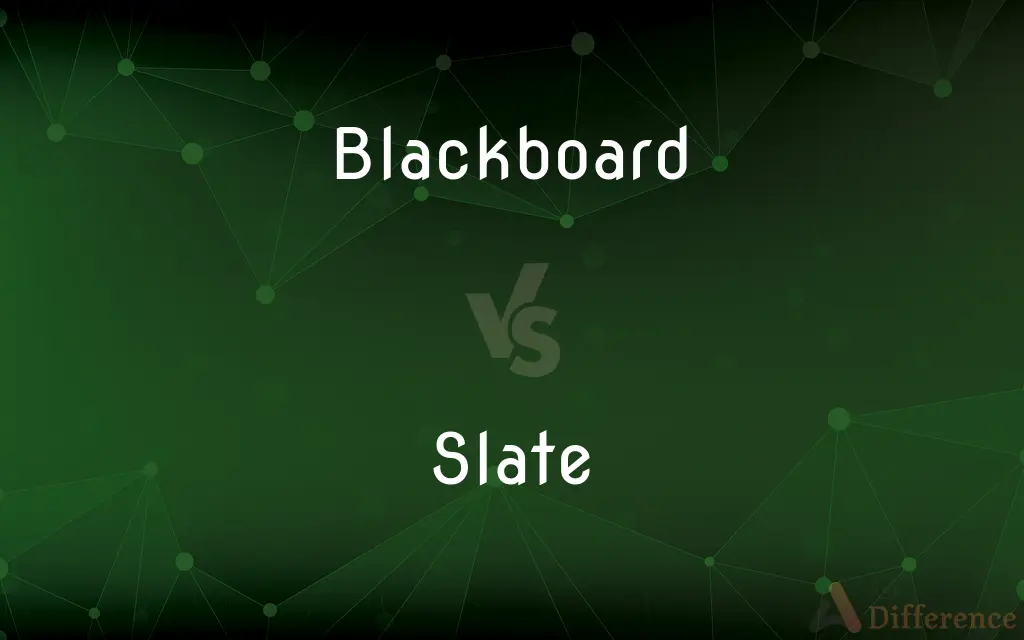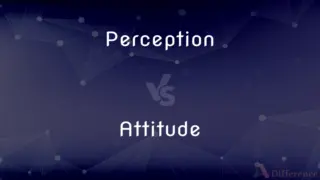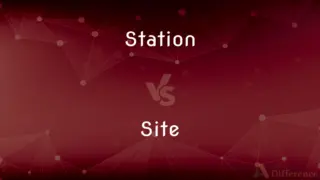Blackboard vs. Slate — What's the Difference?
By Urooj Arif & Fiza Rafique — Updated on March 26, 2024
A blackboard is a large, wall-mounted surface used for writing with chalk, while a slate is a small, handheld writing tool made of slate rock.

Difference Between Blackboard and Slate
Table of Contents
ADVERTISEMENT
Key Differences
Blackboards, traditionally made of smooth, dark surfaces, are commonly used in educational settings for teaching purposes. They allow for writing and drawing with chalk, providing a visual aid for instructors and students. Over time, blackboards have evolved from being made of actual slate to being constructed from other materials, such as painted wood or green boards, yet the name persists. In contrast, slates are smaller, portable pieces of slate rock that were used by individuals for writing or drawing, primarily in the past. These handheld slates were a personal tool for note-taking or practicing writing, easily wiped clean for reuse.
While blackboards are designed for communal viewing in classrooms, lecture halls, or meetings, enabling group learning or discussion, slates were used for individual learning or tasks. This reflects a significant difference in their scale of interaction and purpose. The use of blackboards facilitates a collective educational experience, where a teacher or presenter shares information with an audience. On the other hand, slates were more personal and interactive for the user, serving as a tool for private study, note-taking, or personal expression.
The maintenance and longevity of these tools also differ. Blackboards require regular cleaning with a damp cloth or chalkboard eraser to maintain a clear writing surface and are designed to last many years with proper care. Slates, being made of natural stone, were durable and long-lasting but could break if dropped. They were wiped clean with a simple wet cloth or sponge, ready to be used again.
From an educational technology perspective, blackboards represented an early form of "interactive media" in classrooms, allowing teachers to create dynamic, visual presentations of material. Slates provided students with a reusable writing surface, predating modern tablets and digital devices by centuries. Both were foundational in the evolution of educational tools, catering to different needs within the learning process.
Today, the traditional uses of both blackboards and slates have largely been supplanted by whiteboards and digital devices, respectively. However, blackboards still find use in some educational institutions and settings due to their low cost and simplicity. Handheld slates have become more of a historical or novelty item, with their role in education and personal note-taking replaced by notebooks, tablets, and other digital technologies.
ADVERTISEMENT
Comparison Chart
Size
Large, wall-mounted.
Small, handheld.
Material
Traditionally slate, now also wood or synthetic.
Made of natural slate rock.
Use Case
Teaching, presentations, group learning.
Individual writing, note-taking.
Maintenance
Cleaned with eraser or damp cloth.
Wiped clean with a wet cloth or sponge.
Durability
Long-lasting with proper care.
Durable but can break if dropped.
Compare with Definitions
Blackboard
A large, dark-colored surface for writing with chalk.
The teacher wrote the day's lesson on the blackboard.
Slate
A small piece of slate rock used as a personal writing tool.
Students in the 19th century often used slates for arithmetic practice.
Blackboard
Variants include greenboards and whiteboards.
The school replaced its old blackboards with greenboards for better contrast.
Slate
Predates modern digital tablets.
The slate was an early precursor to today's digital devices for note-taking.
Blackboard
Remains in use for its simplicity and low cost.
In many schools, blackboards are still used due to their straightforward utility.
Slate
Portable and easily cleaned for reuse.
With a damp cloth, the slate was wiped clean, ready for the next task.
Blackboard
Used for group instruction or presentations.
During the workshop, ideas were brainstormed and noted on the blackboard.
Slate
Has become a novelty or historical item.
Antique shops sometimes sell old school slates as decorative pieces.
Blackboard
Can be erased and reused multiple times.
After class, the blackboard was wiped clean for the next day's lessons.
Slate
Was durable but could shatter if dropped.
He dropped his slate on the way to school, breaking it into pieces.
Blackboard
A blackboard (also known as a chalkboard) is a reusable writing surface on which text or drawings are made with sticks of calcium sulphate or calcium carbonate, known, when used for this purpose, as chalk. Blackboards were originally made of smooth, thin sheets of black or dark grey slate stone.
Slate
Slate is a fine-grained, foliated, homogeneous metamorphic rock derived from an original shale-type sedimentary rock composed of clay or volcanic ash through low-grade regional metamorphism. It is the finest grained foliated metamorphic rock.
Blackboard
A large board with a smooth dark surface attached to a wall or supported on an easel and used by teachers in schools for writing on with chalk.
Slate
A fine-grained metamorphic rock that splits into thin, smooth-surfaced layers.
Blackboard
A smooth, hard, dark-colored panel for writing on with chalk.
Slate
A piece of this rock cut for use as roofing or surfacing material or as a writing surface.
Blackboard
A large flat surface, finished with black slate or a similar material, that can be written upon with chalk and subsequently erased; a chalkboard.
Slate
A writing tablet made of a similar material.
Blackboard
To use a blackboard to assist in an informal discussion.
Slate
A record of past performance or activity
Start over with a clean slate.
Blackboard
A broad board painted black, or any black surface on which writing, drawing, or the working of mathematical problems can be done with chalk or crayons. It is much used in schools. In late 20th century similar boards of a green slate as well as some colored white became common; wrioting on the slate bioards may be done with chalk, but writing on the white boards is done with colored pens, such as grease pens, which leaves a trace that can be easily erased. The newer boards, usualy called chalkboards are nevertheless still sometimes referred to as blackboards.
Slate
A list of the candidates of a political party running for various offices.
Blackboard
Sheet of slate; for writing with chalk
Slate
A dark or bluish gray to dark bluish or dark purplish gray.
Slate
Made of a fine-grained metamorphic rock
A slate roof.
Slate
Of the color slate.
Slate
To cover (a roof, for example) with slate.
Slate
To put on a list of candidates.
Slate
To schedule or designate
Our professor has slated the art history lecture for Thursday afternoon.
Was slated to direct the studio's next film.
Slate
A fine-grained homogeneous sedimentary rock composed of clay or volcanic ash which has been metamorphosed so that it cleaves easily into thin layers.
Slate
(uncountable) The bluish-grey colour of most slate.
Slate
(countable) A chalkboard, sheet of slate for writing on with chalk or with a thin rod of slate (a slate pencil) formerly commonly used by both students and teachers in schools.
Slate
(countable) A roofing-tile made of slate.
Slate
(countable) A record of money owed.
Put it on my slate – I’ll pay you next week.
Slate
A list of affiliated candidates for an election.
Slate
An artificial material resembling slate and used for the same purposes.
Slate
A thin plate of any material; a flake.
Slate
A tablet computer.
Slate
Having the bluish-grey/gray colour of slate.
Slate
(transitive) To cover with slate.
The old church ledgers show that the roof was slated in 1775.
Slate
To criticise harshly.
The play was slated by the critics.
Slate
To schedule.
The election was slated for November 2nd.
Slate
To anticipate or strongly expect.
The next version of our software is slated to be the best release ever.
Slate
To set a dog upon (a person).
Slate
To nominate, appoint, or designate.
Slate
An argillaceous rock which readily splits into thin plates; argillite; argillaceous schist.
Slate
Any rock or stone having a slaty structure.
Slate
A prepared piece of such stone.
Slate
An artificial material, resembling slate, and used for the above purposes.
Slate
A thin plate of any material; a flake.
Slate
A list of candidates, prepared for nomination or for election; a list of candidates, or a programme of action, devised beforehand.
Slate
To cover with slate, or with a substance resembling slate; as, to slate a roof; to slate a globe.
Slate
To register (as on a slate and subject to revision), for an appointment.
Slate
To set a dog upon; to bait; to slat. See 2d Slat, 3.
Slate
(formerly) a writing tablet made of slate
Slate
Thin layers of rock used for roofing
Slate
A fine-grained metamorphic rock that can be split into thin layers
Slate
A list of candidates nominated by a political party to run for election to public offices
Slate
Designate or schedule;
He slated his talk for 9 AM
She was slated to be his successor
Slate
Enter on a list or slate for an election;
He was slated for borough president
Slate
Cover with slate;
Slate the roof
Common Curiosities
How did students use slates in classrooms historically?
Students used slates for writing, arithmetic, and practicing penmanship. They were a cost-effective tool since they could be erased and reused indefinitely.
Can you still buy slates for personal use?
Yes, slates are available for purchase, often as novelty items, educational tools for children, or for specific uses in art and craft projects.
Are there any advantages of blackboards over modern digital displays?
Blackboards do not require electricity, making them useful in areas with unreliable power. They also offer a tactile learning experience that some educators and learners prefer.
Why were blackboards replaced by whiteboards in many places?
Whiteboards offer a dust-free alternative to chalkboards, are easier to clean, and compatible with non-permanent markers, making them more convenient for many users.
Is slate a sustainable material?
Slate is a natural, durable material that, if sourced responsibly, can be considered more sustainable than synthetic alternatives. However, its extraction and transportation have environmental impacts.
What happened to the use of slates in education?
Slates were gradually phased out with the advent of affordable paper, notebooks, and, more recently, digital devices that offer more versatility for learning and note-taking.
Do any educational institutions still use blackboards?
Yes, some schools, colleges, and universities continue to use blackboards, especially in settings where the simplicity and tactile nature of chalk writing are valued.
How was slate sourced for making slates and blackboards?
Slate was quarried from slate-rich regions, such as Wales in the UK or the Slate Valley in the United States, and then cut and finished into the desired sizes for slates or blackboard surfaces.
What's the difference between a blackboard and a chalkboard?
There is no difference; "blackboard" and "chalkboard" are interchangeable terms, though "chalkboard" can sometimes refer to boards of any color used with chalk.
Are chalk dust from blackboards harmful to health?
Inhalation of excessive chalk dust, particularly over prolonged periods, can irritate respiratory passages. Ventilation and minimal dust chalks are recommended to mitigate health risks.
Can blackboards be used outdoors?
Yes, blackboards can be used outdoors, especially those made with weather-resistant materials, but they should be protected from direct rain and excessive moisture to prevent damage.
How have blackboards evolved in educational settings?
Blackboards have evolved from slate to painted wood or synthetic materials, and now often complement digital teaching tools, maintaining their role in fostering interactive learning.
How do you properly maintain and clean a blackboard?
To maintain a blackboard, use a felt or foam eraser for daily cleaning and a damp cloth for a deeper clean, avoiding abrasive cleaners that can damage the surface.
Can digital tablets completely replace slates in education?
Digital tablets offer more functions and flexibility than slates and have largely replaced them; however, the simplicity and low cost of slates still make them useful in certain educational contexts.
Are there modern uses for slate beyond education?
Beyond education, slate is used in roofing, flooring, and as a durable, natural material in home decor and landscaping projects due to its aesthetic appeal and longevity.
Why did students use slates instead of paper historically?
Historically, paper was expensive and less durable, making slates a cost-effective, reusable alternative for daily classroom activities and homework.
What are the environmental impacts of using slate?
While slate is a natural, durable material with a long lifespan, quarrying and transporting slate can have significant environmental impacts, including habitat disruption and carbon emissions from transportation.
Share Your Discovery

Previous Comparison
Perception vs. Attitude
Next Comparison
Station vs. SiteAuthor Spotlight
Written by
Urooj ArifUrooj is a skilled content writer at Ask Difference, known for her exceptional ability to simplify complex topics into engaging and informative content. With a passion for research and a flair for clear, concise writing, she consistently delivers articles that resonate with our diverse audience.
Co-written by
Fiza RafiqueFiza Rafique is a skilled content writer at AskDifference.com, where she meticulously refines and enhances written pieces. Drawing from her vast editorial expertise, Fiza ensures clarity, accuracy, and precision in every article. Passionate about language, she continually seeks to elevate the quality of content for readers worldwide.












































